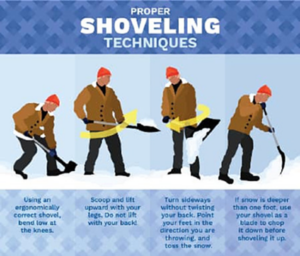Winter is Here – A Guide to Safe Lifting and Bending When Shoveling Snow
By Jessica Lowy PT,DPT,CMTPT,SSOL Advanced Schroth Clinician, McKenzie A-D
Michal (Micky) Porath PT,MPT, SSOL Advanced Schroth Clinician, McKenzie A-D
Every winter a patient comes into the clinic after injuring their back from shoveling snow. Body mechanics plays a crucial role in preventing injuries and promoting overall well-being, especially when it comes to activities like lifting and bending. Whether you’re an athlete, a fitness enthusiast, or someone simply going about daily tasks, understanding and practicing proper body mechanics can significantly reduce the risk of strains, sprains, and other musculoskeletal issues. Physical therapy educates individuals in mastering body mechanics essential for rehabilitation and long-term health.
The Basics of Body Mechanics:
Body mechanics refers to the coordinated efforts of muscles, bones, and joints to maintain balance, posture, and alignment during various activities. Proper body mechanics are essential to distribute force evenly across the body, preventing undue stress on specific muscles or joints. When lifting or bending, adopting the right posture and movement patterns is crucial for minimizing the risk of injuries. The following are practical tips to enhance safety and efficiency during bending and lifting.
Maintain a Stable Base:
Before lifting an object, position your feet shoulder-width apart to create a stable base. Distribute your weight evenly on both feet to enhance balance and prevent unnecessary strain on one side of the body.
Bend at the Hips and Knees:
Instead of bending from your back, which can strain the lower back, keep your back straight and upright while bending at the hips and knees. This engages the powerful muscles in your legs and reduces stress on the spine.
Keep the Load Close:
Hold the object close to your body while lifting. This minimizes the leverage on your spine, reducing the strain on your back muscles.
Lift with Your Legs:
Engage the muscles in your legs, especially the quadriceps and glutes, when lifting. Push through your heels to stand up, using the strength of your lower body rather than relying solely on your back.
Avoid Twisting:
When lifting, avoid twisting your body. Instead, pivot your feet to change direction, keeping the load centered in front of you.
Now that the winter months are here. It is important to talk about proper body mechanics with snow shoveling. Shoveling snow can be a strenuous activity, and practicing proper body mechanics is crucial to prevent injuries and strains. Begin by selecting a snow shovel with an ergonomic design and an appropriate length to reduce the strain on your back. Using the techniques that we just spoke about for bending and lifting is key to back protection. Standing with feet shoulder-width apart, maintain a straight spine. When lifting snow, bend at the hips and knees, keep the shovel close to your body and use your leg muscles to lift, transferring the weight through your hips rather than relying solely on your back. Take frequent breaks, listen to your body, and avoid overexertion. Additionally, consider pushing the snow to the side rather than lifting it when possible. Lastly, if you experience any discomfort or pain, stop immediately and seek professional advice. By incorporating these proper body mechanics, you can make snow shoveling a safer and more efficient winter chore.

Incorporating proper body mechanics into lifting and bending activities is essential for preventing injuries and supporting overall physical well-being. Whether you’re recovering from an injury or looking to enhance your daily movements, these principles of body mechanics provide a solid foundation for safe and efficient practices. Remember that consistency and mindfulness in your movements are key to reaping the long-term benefits of incorporating proper body mechanics into your daily routine. Always consult with a healthcare professional or physical therapist for personalized guidance based on your specific needs and conditions.
At Prime Orthopedic Rehabilitation, we have both male and female therapists. Our therapists all hold advanced certifications to help with your specific needs, including OCS certification, Orthopedic Certified Specialist. We offer general outpatient physical and occupational therapy, both In-Office and In-Home, but we also offer specific approaches such as McKenzie rehab for neck and back issues, Schroth approach for scoliosis, Vestibular rehab for dizziness, balance issues and vertigo, Sports rehab for sports injuries such as those from basketball or hockey, as well as therapists certified in dry needling, cupping, instrument assisted soft tissue mobilization (IASTM) and other approaches. Prime also has seventy 5-star google reviews and offers more one on one time than most other offices. Call us today to ask how we can help you 201-503-7173.
Jessica Lowy, DPT, CMTPT, DN, Mckenzie A-D, Advanced Schroth Clinician and Michal Porath, MPT, Mckenzie A-D, Advanced Schroth Clinician are owners of Prime Orthopedic Rehabilitation in Tenafly, NJ. They treat general orthopedic and post surgical patients, in addition to children and adults with scoliosis. Call (201) 503-7173 for an appointment.
Disclaimer
The medical/health information is provided for general informational and educational purposes only and is not a substitute for professional advice. Accordingly, before taking any actions based upon such information, we encourage you to consult with the appropriate professionals. The use or reliance of any information contained on this site is solely at your own risk. All information on this site is provided in good faith, however we make no representation or warranty of any kind, express or implied, regarding the accuracy, adequacy, validity, reliability, availability, or completeness of any information on this site.
